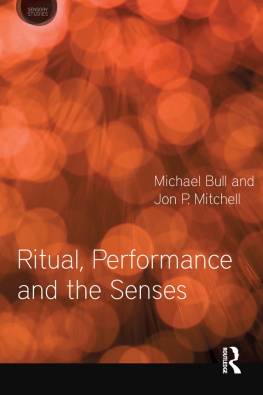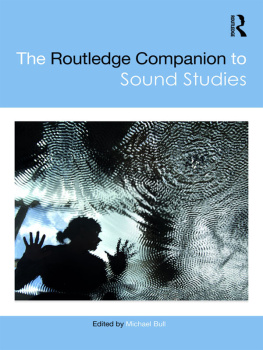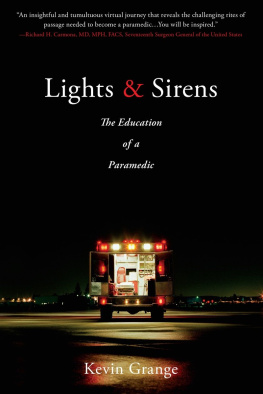Sirens
The Study of Sound
Editor: Michael Bull
Each book in The Study of Sound offers a concise look at a single concept within the field of sound studies. With an emphasis on the interdisciplinary nature of the topics at hand, the series explores a range of core issues, debates, and objects within sound studies from a variety of perspectives and within a multitude of contexts.
Editorial Board:
Carolyn Birdsall , Assistant Professor of Television and Cross-Media Culture, University of Amsterdam, The Netherlands
Martin Daughtry , Assistant Professor of Music, Arts and Humanities, NYU, USA
Michael Heller , Associate Professor, Department of Music, University of Pittsburgh, USA
Brian Kane , Associate Professor, Department of Music, Yale University, USA
Marie Thompson , Lecturer, School of Film and Media, University of Lincoln, UK
James Mansell , Assistant Professor of Cultural Studies, Department of Culture, Film and Media, University of Nottingham, UK
Published Titles:
The Sound of Nonsense by Richard Elliott
Humming by Suk-Jun Kim
Lipsynching by Merrie Snell
Sonic Fiction by Holger Schulze
Forthcoming Titles:
Sonic Intimacy by Malcolm James
Wild Sound by Michael Pigott
In memory of my good friend
Walter Harris (19252019)
Writer, Broadcaster and Raconteur
Sirens
Michael Bull

Contents
When embarking upon writing the present volume inquisitive friends asked me what the topic of the book was. On telling them that I was writing a book on Sirens some looked surprised Why do you want to write a book on mermaids? they would ask. Others would exclaim, Oh yes, a book on music!. One sound scholar excitedly commented, Yes, a book on police sirens is just what is needed! and so on. The book series to which this volume contributes aims to interrogate a single concept, object or issue through the lens of sound studies broadly conceived. The study of sound crosses disciplinary boundaries as does the study of Sirens. In addition to the cross-disciplinary nature of the study is a vagueness attached to both the nature of the object a Siren and what it signifies. The study of Sirens is beset with two significant problems; that of an intellectual division of labour encouraging specialization of topic and area; and an inherent ambiguity as to what the object of study is: the Siren/siren.
Sirens in one form or another are studied widely in literature, philosophy, history, classical studies, cultural and film studies, anthropology, architecture, music, ethnomusicology and, more recently, in sound studies. The page of text in which Odysseus confronts the Sirens is one of the most cited pages in Western cultural history with each age breathing new life into the sails of the Siren myth. Sirens have spawned hundreds of books and many thousands of pages of analysis over the last three thousand years. Of less interest are the more recent technological sirens of urban culture the ones that we hear in daily life. These sirens have a much shorter history than the mythical Sirens from whom they derive their name.guides for ships as they entered the ports of New York, London and elsewhere. Equally, air-raid sirens were a dominant presence in the soundscapes of cities during the Second World War and the Cold War remaining, to this day, as warnings of danger from the air but also as warnings against potential natural disasters.
Siren studies tend to reside within disciplinary boundaries rather than existing between them. For example, there is much work undertaken under the rubric of classical studies and Greek studies with book series covering writings on Myths and Poetics within the classical period for example. These writings rarely stray from their Classical subject matter, even though they might choose to focus on the presentation of a specific area of concern such as the representation of women in the work of Homer they rarely move beyond their period of study (Sirens/sirens both prosper and suffer represents an intellectual division of labour from which sound studies itself is not immune.
Sound studies has largely restricted itself to the investigation of sirens that pass us by on the street while neglecting those Sirens of popular culture. Yet, even its treatment of these industrial sirens has remained, at best, partial. While it is the case that sound studies has shown a greater partiality to the vibrations of mechanical sirens to those Sirens that sing, it often confines its analysis to the difficulties surrounding the recognition and placing of sirens sounds emanating from the vehicles of the emergency services within the spaces of cities, often New York. This work, largely functionalist in orientation, focuses on the hearing of, and placement and design of, sirens in an attempt to improve upon and overcome obstacles to hearing. These challenges to hearing are historical, empirical and technological. How, for example, might siren warnings be heard in the seclusion of hermetically sealed automobiles, or in concreted apartment blocks or offices or in underground tube stations and so on. How might sonic information be adequately targeted at potential listeners so that they trust these warning sounds and respond appropriately (a world of competing sounds. When briefly alluding to the Sirens of mythology in reference to the novels of Franz Kafka and James Joyce he restricts his discussion to the role that the First World War played in the experience of the authors rather than, for example, to the cultural and historical meanings of the gendering of Sirens in their work. This issue forms a central component in the present work.
These disciplinary issues are exacerbated by the shifting nature of meanings attached to the very study and understanding of sirens. Sirens are mythical, material and constantly metamorphizing; they are the subject of Greek myth, of Victorian hypocrisy, of male domination, the subject of film, literature and music, an essential component in the defence of citizens and cities in wartime and in times of natural disasters, they are a dialectical representative of the conflicting nature of Enlightenment thought. They represent a multiplicity of perspectives and subject matter joined by one term siren. In daily life we confront the sirens of the emergency services, in some parts of the world remaining air-raid sirens warn of earthquakes or tsunamis. We read of aquatic creatures called sirens or mermaids, see them on screen, as paintings in art galleries, listen to the siren songs of Debussy, Dizzy Rascal or Wolf Alice. This very multiplicity spawns vagueness and imprecision. Dictionary definitions do not clarify but merely compound confusion. The Oxford English Dictionary gives similar definitions of sirens to every other major dictionary in defining them as,
Greek mythology. Any of several women or winged creatures, half woman half bird, whose singing was supposed to lure unwary sailors to destruction on the rocks. Formerly also a mermaid.
The Oxford definition remains ambiguous from the beginning. Are Sirens women or some other creature? Why would their song lure sailors onto the rocks? Neither is the metamorphosis of women into Sirens or later mermaids commented upon. Indeed the historical derivation is mistaken, as mermaids were invented after the mythical Homeric Sirens. The dictionary definition continues:
A woman who sings sweetly; a dangerously fascinating woman, a temptress; anything tempting or alluring.
The dictionary divides Sirens into either women who sing or who are tempting in some unspecified way. The object of this temptation is left unclear it is not apparent whether anything includes mechanical sirens which emit noise or music; if so it is not clear through which technological medium this might happen. Only in the final brief definition of sirens to be used as an adjective might the two disparate sirens come together. The most confusing aspect of the dictionary definition is its rapid movement from the Sirens of Greek mythology to embodying the myth to include initially some women before moving on to include all women as Sirens before broadening the definition to refer to anything that is tempting. This definition exists firmly within the tropes of Western popular culture and is increasingly alluded to in Siren critical discourse which opens out the subject of siren to include almost anything. This second definition does potentially move away from the heterosexual assumption of the first by not defining who it is that is being tempted. The metamorphizing of the Sirens, an issue addressed in the work of might explain its attraction, as a term, to the LGBT movement who selectively use the term organizationally.















